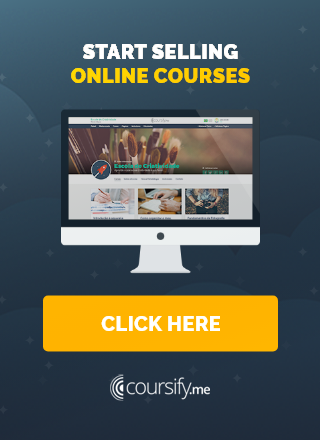How to make a great presentation to sell eLearning courses
Technological advance, pandemic, lack of time, increased competition in the job market, demand for more qualified labor, are just some of the reasons that make the demand for eLearning courses more and more frequent.
In a fast-paced and competitive market, if you want to sell online courses, you need to get attention. As the first impression is usually the one that stays, our first tip is: make a great presentation.

ELearning Courses: First steps to create a good presentation and attract audience
Making a good presentation starts with the way you convey your idea and elaborate your content. No matter how compelling your message is, if you don’t get it out of your brain and onto the screen in a simple way, your engagement will be minimal.
Producing content thinking strategically makes all the difference when selling your elearning courses.
So, before you start worrying about font, images, number of slides and all the technical details, think about the best way to get your message through.
Think like your student
As with any niche market, if you want to sell something, you have to know who your target audience is and what they want.
Knowing your audience’s interests, desires, and pain points, you can better address them through your presentation and make it more relevant.
For example, an advanced presentation full of technical jargon might not be the best idea if you are targeting someone who is new in your field and not familiar with complicated terms.
It can end up confusing them instead of leaving a strong impact. You need to be able to speak your audience’s language and serve them at their level, because if they don’t understand what you mean from the beginning, they will certainly not invest in your elearning courses.
– How to find out what my audience wants and attract leads
Decide the purpose of your presentation
For every presentation you create, you need to have a purpose in mind and clear objectives.
The purpose of each presentation can be summarized in one of the following purposes:
- Inform
- Entertain
- Inspire
- Persuade
The purpose of your presentation may even be a combination of the four above.
The idea of identifying the purpose is to help you create the subject, outline, and structure of your presentation more easily.
Tell a story
The beginning of your presentation is crucial. You need to grab your audience’s attention and hold it early on.
Remember that a person’s attention span surfing the internet these days is just a few seconds, so don’t waste it explaining who you are. Start by entertaining your audience, start by telling a story.
Human beings are programmed to respond to stories.
Stories help us to pay attention and also to remember things. If you can use stories in your presentation, your audience is more likely to engage and remember what was said afterwards.
To do this, think about what story you want to tell and design your presentation with that in mind.
Smile and make eye contact with your audience
If you are going to show up in your presentation, this tip is crucial and it may seem simple, but believe me, many people have a hard time doing this.
By smiling and making eye contact, you’re not just being friendly, you’re doing something much more important, which is building a relationship with your audience, helping them connect with you and your subject.
Think that you are talking to a friend, someone you know, this will help you feel less nervous and make your tone of voice more natural and dynamic.
Your body language is also important in getting your message across in the right way. Avoid folded arms, hands behind your back or in your pockets, and pacing.
Make open and confident gestures and move naturally, conveying confidence to the viewer. After all, if they are going to buy elearning courses from you, they first need to trust your authority.
– 7 Tips to Speak Well in Video
ELearning Courses: How to create a great PowerPoint presentation
Often underestimated, PowerPoint has all the tools you need to present your idea, business or course.
The trick is in knowing how to format your presentation, how to tell your story.
Every day several projects are presented through a sequence of slides in PowerPoint, and it doesn’t matter if you are a great CEO, speaker or if you have never presented anything before, if you know how to tell your story, you can interest and inspire anyone.
Creating a great presentation using this tool is simpler than you might think and you always can use ready online education powerpoint templates to make even easier.
To help, we’ve separated some simple strategies to apply.
Structure your story
We’ve already mentioned that the trick is knowing how to tell your story, but let’s not forget that, in the case of a presentation that intends to convey a message, it needs to be, above all, logical. So, establish a beginning, middle and end.
Guy Kawasaki, one of the world’s leading experts in the fields of Technology and Marketing, tells us about his method for structuring presentations: “A PowerPoint presentation should have ten slides, no longer than twenty minutes, and no font smaller than thirty points.”
Of course, depending on your goal, it may be necessary to extend the presentation a little further, as in the case of a pre-launch class for your course, for example.
The important thing is that your story fulfills three goals: point out the problem, present the challenge, and explain how to solve it.
– How to Pre-Launch Online Courses
Go easy with the words
No one likes to look at a screen with squished letters and endless sentences. It sounds obvious, but it’s so common that it’s why PowerPoint presentations are underrated. Most people tend to automatically associate them with some boring class they’ve already attended, filled with overcrowded slides.
A good presentation should contain only the main information. Many people choose to use only one sentence per slide, or even just one image and keyword, which, despite seeming strange, is a very efficient technique, as it makes the viewer think about what he is seeing.
Seth Godin, the king of marketing, says we should only have six words per slide. Choose your words carefully and rewrite until you get it right.
The audience needs time to digest the information. A constant flow of words is quite exhausting for the mind and ends up tiring the viewer. Don’t be afraid to innovate and expose as little as necessary.
Less is more
It is common to see in presentations the excessive use of the famous clip-arts, that is, what everyone has the same and is tired of seeing.
Only use what is relevant to your content.
While graphics, videos or images are good resources to make explanations more visual and easier to understand, use only what is necessary to be understanded. Do not abuse fonts, colors and effects, they will only interfere with the final result.
In short:
- Use color sparingly: Use the colors most relevant to your message. We recommend setting one or two (not counting black and white) so your presentation looks harmonious.
- Be consistent with your font: Choose a font and size and use it as the default on all slides. Keep your on-screen text uniform for a more cohesive message.
- Format carefully: A crooked line or a poorly pixelated graphic makes a bad impression. Make sure your text is aligned, organized, and that all images and other visuals used, such as animations, are of good quality. Consistent design makes you look more professional.
Include practical examples
Including numbers and data in your presentation is great, but if you don’t relate this information to the real world (i.e. contextualize), your audience may get lost or bored.
One way to add context to your presentation content is to include lots of practical examples. Telling people what a particular piece of information might mean to them in their everyday life, for example, has a much stronger impact than simply telling them that the information exists.
Plus, relatable examples can make your presentation message easier to digest and understand.
To sell elearning courses, telling stories of transformation is usually a determining factor in making a purchase decision. Show your audience concretely how your course can change their lives.
If you already have graduates and successful cases, ask for permission to share their stories, and if you can insert testimonials into your slides, even better.
– How to Create a Powerful Sales Copy
Review and Rehearse
Most presentations are for background material only. Ideally, it should be accompanied by a spoken explanation, in which case the presenter needs to avoid becoming “a full slide”, that is, monotonous.
Review your content and practice speaking, learn to talk about it as you would like to hear it, after all, if you can’t get excited about your own presentation, no one else will.
Many people don’t feel comfortable speaking in public, or, even if they just give a narrative, without appearing, they feel intimidated. The only solution to this is to rehearse.
Repeat your explanation over and over again, even if it’s to yourself in front of the mirror. Mastering the subject is the first step to gaining confidence, so practice until you feel ready and comfortable.
The audience senses when someone understands what they are talking about and this is critical to keeping their attention and building your authority.
Choose the right platform to sell your eLearning courses

PowerPoint is an easy-to-use tool and several tutorials can be found on the Internet for those who want to explore its resources a little more.
Have your presentation ready to win over your audience, create your online school on Coursify.me, upload your content and start promoting your course.
ELearning platform (LMS), Coursify.me has all the necessary resources for you to integrate and import content from your computer, Dropbox, and sites like Vimeo and YouTube.
To learn more, visit our website, take a free trial and enjoy all the resources it offers for you to create and sell quality elearning courses.
– Practical guide to creating and selling online courses
If you have any questions,

